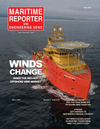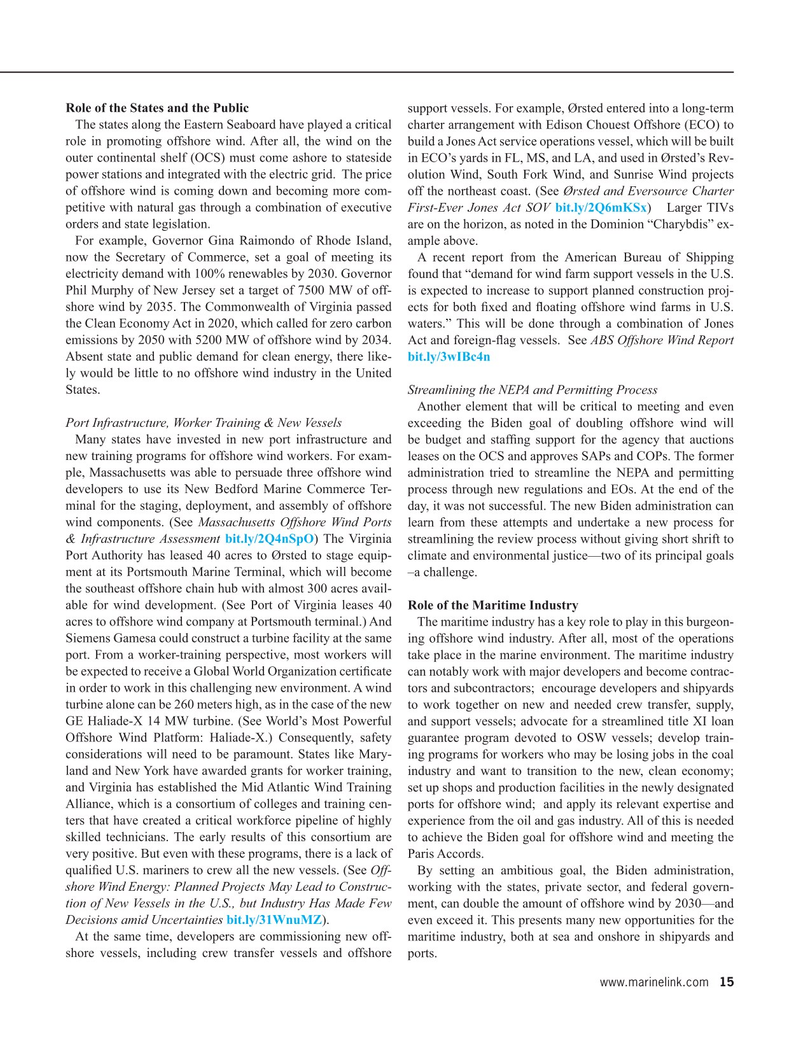
Page 15: of Maritime Reporter Magazine (April 2021)
Offshore Wind Energy: Installation, Crew & Supply Vessels
Read this page in Pdf, Flash or Html5 edition of April 2021 Maritime Reporter Magazine
Role of the States and the Public support vessels. For example, Ørsted entered into a long-term
The states along the Eastern Seaboard have played a critical charter arrangement with Edison Chouest Offshore (ECO) to role in promoting offshore wind. After all, the wind on the build a Jones Act service operations vessel, which will be built outer continental shelf (OCS) must come ashore to stateside in ECO’s yards in FL, MS, and LA, and used in Ørsted’s Rev- power stations and integrated with the electric grid. The price olution Wind, South Fork Wind, and Sunrise Wind projects of offshore wind is coming down and becoming more com- off the northeast coast. (See Ørsted and Eversource Charter petitive with natural gas through a combination of executive First-Ever Jones Act SOV bit.ly/2Q6mKSx) Larger TIVs orders and state legislation. are on the horizon, as noted in the Dominion “Charybdis” ex-
For example, Governor Gina Raimondo of Rhode Island, ample above.
now the Secretary of Commerce, set a goal of meeting its A recent report from the American Bureau of Shipping electricity demand with 100% renewables by 2030. Governor found that “demand for wind farm support vessels in the U.S.
Phil Murphy of New Jersey set a target of 7500 MW of off- is expected to increase to support planned construction proj- shore wind by 2035. The Commonwealth of Virginia passed ects for both ? xed and ? oating offshore wind farms in U.S. the Clean Economy Act in 2020, which called for zero carbon waters.” This will be done through a combination of Jones emissions by 2050 with 5200 MW of offshore wind by 2034. Act and foreign-? ag vessels. See ABS Offshore Wind Report
Absent state and public demand for clean energy, there like- bit.ly/3wIBc4n ly would be little to no offshore wind industry in the United
States. Streamlining the NEPA and Permitting Process
Another element that will be critical to meeting and even
Port Infrastructure, Worker Training & New Vessels exceeding the Biden goal of doubling offshore wind will
Many states have invested in new port infrastructure and be budget and staf? ng support for the agency that auctions new training programs for offshore wind workers. For exam- leases on the OCS and approves SAPs and COPs. The former ple, Massachusetts was able to persuade three offshore wind administration tried to streamline the NEPA and permitting developers to use its New Bedford Marine Commerce Ter- process through new regulations and EOs. At the end of the minal for the staging, deployment, and assembly of offshore day, it was not successful. The new Biden administration can wind components. (See Massachusetts Offshore Wind Ports learn from these attempts and undertake a new process for & Infrastructure Assessment bit.ly/2Q4nSpO) The Virginia streamlining the review process without giving short shrift to
Port Authority has leased 40 acres to Ørsted to stage equip- climate and environmental justice—two of its principal goals ment at its Portsmouth Marine Terminal, which will become –a challenge. the southeast offshore chain hub with almost 300 acres avail- able for wind development. (See Port of Virginia leases 40 Role of the Maritime Industry acres to offshore wind company at Portsmouth terminal.) And The maritime industry has a key role to play in this burgeon-
Siemens Gamesa could construct a turbine facility at the same ing offshore wind industry. After all, most of the operations port. From a worker-training perspective, most workers will take place in the marine environment. The maritime industry be expected to receive a Global World Organization certi? cate can notably work with major developers and become contrac- in order to work in this challenging new environment. A wind tors and subcontractors; encourage developers and shipyards turbine alone can be 260 meters high, as in the case of the new to work together on new and needed crew transfer, supply,
GE Haliade-X 14 MW turbine. (See World’s Most Powerful and support vessels; advocate for a streamlined title XI loan
Offshore Wind Platform: Haliade-X.) Consequently, safety guarantee program devoted to OSW vessels; develop train- considerations will need to be paramount. States like Mary- ing programs for workers who may be losing jobs in the coal land and New York have awarded grants for worker training, industry and want to transition to the new, clean economy; and Virginia has established the Mid Atlantic Wind Training set up shops and production facilities in the newly designated
Alliance, which is a consortium of colleges and training cen- ports for offshore wind; and apply its relevant expertise and ters that have created a critical workforce pipeline of highly experience from the oil and gas industry. All of this is needed skilled technicians. The early results of this consortium are to achieve the Biden goal for offshore wind and meeting the very positive. But even with these programs, there is a lack of Paris Accords. quali? ed U.S. mariners to crew all the new vessels. (See Off- By setting an ambitious goal, the Biden administration, shore Wind Energy: Planned Projects May Lead to Construc- working with the states, private sector, and federal govern- tion of New Vessels in the U.S., but Industry Has Made Few ment, can double the amount of offshore wind by 2030—and
Decisions amid Uncertainties bit.ly/31WnuMZ). even exceed it. This presents many new opportunities for the
At the same time, developers are commissioning new off- maritime industry, both at sea and onshore in shipyards and shore vessels, including crew transfer vessels and offshore ports. www.marinelink.com 15
MR #4 (1-17).indd 15 4/7/2021 8:46:36 AM

 14
14

 16
16
